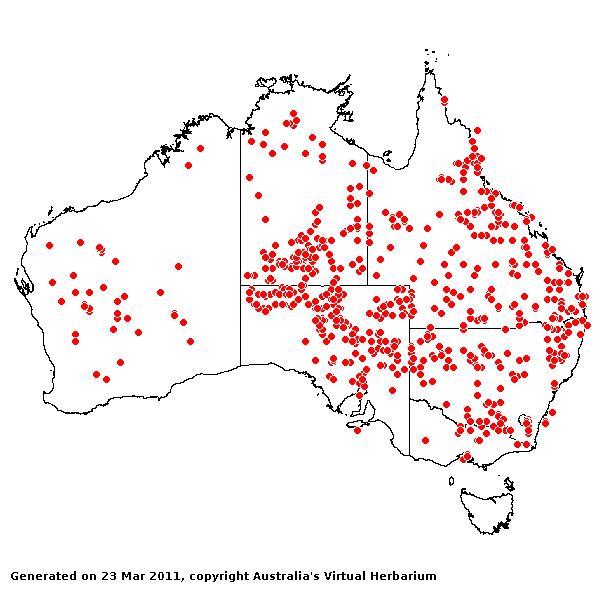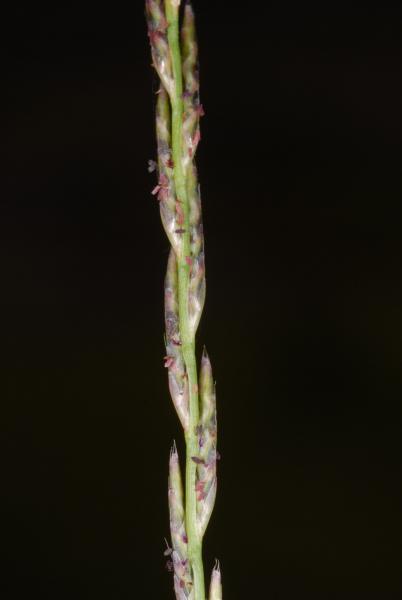Tripogon loliiformis (F. Muell.)
C.E.Hubb. Bull. Misc. Inform. 448(1934).
Classification.
(GPWG 2001) : Subfamily Chloridoideae. Cynodonteae.
Basionym and/or
Replacement Name: Festuca
loliiformis F. Muell., Fragm. 8: 128 (1873).
Type of Basionym or
Protologue Information: ST: Bowman s.n., Australia: Suttor's River
ST: Leichhardt s.n., Australia: ad Noreton's Bay ST: Leichhardt s.n.,
Australia: Charley's Creek ST: Bowman s.n., Australia: Walloon ST: Bowman
s.n., Australia: Gracemere ST: Bowman s.n., Herbert's Creek ST: O'Shanesy
s.n., Australia: Rockhampton ST: J. Drummond 976, Australia
occidentali extratropica.
Key references
(books and floras): [1878] G.Bentham, Flora Australiensis 7 (618 as Diplachne
loliiformis), [1952] C.A.Gardner, Flora of Western Australia 1 Gramineae
(205), [1981] M.Lazarides in J.Jessop (ed)., Flora of Central Australia
(461), [2002] D.Sharp & B.K.Simon, AusGrass, Grasses of Australia,
[2006] J.Jessop, G.R.M.Dashorst, F.M.James, Grasses of South Australia
(405), [2008] S.W.L.Jacobs, R.D.B.Walley & D.J.B.Wheeler, Grasses of New
South Wales (389).
Illustrations: [1952]
C.A.Gardner, Flora of Western Australia 1 Gramineae (206, Pl.61),
[1984] N.T.Burbidge. rev. S.W.L.Jacobs, Australian Grasses (263), [2005] K.Mallet (ed.), Flora of
Australia 44B: Poaceae 3 (Fig. 73A-E), [2006] J.Jessop,
G.R.M.Dashorst, F.M.James, Grasses of South Australia (404, Fig. 336), [2008] S.W.L.Jacobs,
R.D.B.Whalley & D.J.B.Wheeler, Grasses of New South Wales, 4th edn
(389).
Habit. Annual
or perennial. Culms erect, 3.5–55 cm tall, 1–4 -noded. Mid-culm internodes
pubescent. Mid-culm nodes glabrous. Lateral branches simple. Leaves mostly
basal. Ligule a fringed membrane, a ciliate membrane, 0.1–2 mm long.
Leaf-blades flat or conduplicate or convolute, 1–7.5 cm long, 0.5–1.3 mm wide.
Leaf-blade surface glabrous or indumented.
Inflorescence.
Inflorescence solid or compound, a raceme, a panicle of racemes. Racemes 1,
erect, straight, 2–9.5(–17) cm long.
Spikelets.
Spikelets sessile. Fertile spikelets many flowered, with at least 2 fertile
florets (5–18), comprising 5–18 fertile floret(s), with diminished florets at
the apex, linear or oblong, laterally compressed, 4–12(–22) mm long.
Glumes. Glumes
similar. Lower glume lanceolate or ovate, membranous, keeled, 1-keeled, 1
-nerved. Upper glume lanceolate or oblong or ovate, 2–3.5(–5.2) mm long, membranous,
keeled, 1-keeled, 1–3 -nerved.
Florets.
Fertile lemma 1.9–3.5(–4.5) mm long, without keel, 3 -nerved. Lemma apex
dentate, mucronate. Median (principal) awn 0.6–1 mm long overall. Palea 2
-nerved. Anthers 2. Grain 1–2.2 mm long.
Continental
Distribution: Tropical Asia and Australasia.
Australian
Distribution: Western Australia, Northern Territory, South Australia,
Queensland, New South Wales, Victoria.
Western Australia:
Giles, Helms, Fortescue, Ashburton, Carnarvon, Austin. Irwin, Avon, Coolgardie.
Northern Territory: Darwin & Gulf, Barkly Tableland, Central
Australia North, Central Australia South. South Australia:
North-western, Lake Eyre, Gairdner-Torrens Basin, Flinders Ranges, Eastern,
Eyre Peninsula, Murray. Queensland: Burke, Burnett, Cook, Darling Downs,
Gregory North, Leichhardt, Maranoa, Mitchell, Moreton, North Kennedy, Port
Curtis, South Kennedy, Warrego, Wide Bay, Gregory South. New South Wales:
Northern Tablelands, Southern Tablelands, North-Western Slopes, Central-Western
Slopes, South-Western Slopes, North-Western Plains, South-Western Plains, North
Far Western Plains. Victoria: East Gippsland, Grampians, Midlands,
Riverina, Volcanic Plain, Wimmera.
Notes.
This species is termed a 'resurrection plant' as it is able to produce green
leaf from dry butts, and flowers and fruits in a very short time after rain.
Morphologically variable in inflorecence form
and spikelet arrangement; further work is required to determine if 2 species
are represented.
Occurs in all mainland
states in Australia.; most common in Central and Eastern Australia, also in
Papua and New Guinea. In a variety of habitats: rocky slopes, plateaux and
outcrops of granite and sandstone in skeletal reddish soils with spinifex; on
plains in red sand or sandy to clayey loams in open Acacia woodlands
especially Mulga; depressions and creeklines on gibber plains with chenopods;
floodplains in red to brown clayey soils in open eucalypt woodland; rocky
slopes and outcrops of granite in pockets of sandy loam in eucalypt forest or Callitris
and eucalypt woodland with a grassy understorey.; flowers and fruits throughout
the year.





